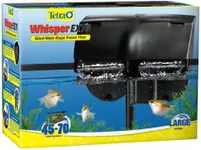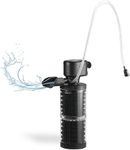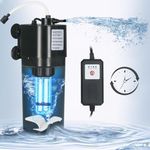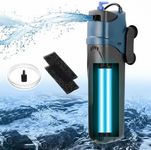Buying Guide for the Best Submersible Fish Tank Filter
Choosing the right submersible fish tank filter is essential for maintaining a healthy and clean aquarium environment. The filter helps remove waste, uneaten food, and harmful chemicals from the water, ensuring your fish stay healthy and the water remains clear. When picking a filter, it's important to consider the size of your tank, the type of fish you have, and how much maintenance you're willing to do. Understanding the key specifications will help you make a choice that fits your aquarium's needs and keeps your aquatic pets happy.Flow RateFlow rate refers to how much water the filter can process in a given amount of time, usually measured in gallons per hour (GPH) or liters per hour (LPH). This is important because it determines how effectively the filter can clean your tank. For small tanks, a lower flow rate is usually sufficient, while larger tanks need a higher flow rate to ensure all the water is filtered regularly. As a general rule, the filter should be able to process all the water in your tank at least 3-5 times per hour. If you have delicate fish or plants, a gentler flow is better, while tanks with more active fish or higher waste production may need a stronger flow.
Filtration StagesFiltration stages refer to the different types of cleaning the filter provides, such as mechanical (removing debris), biological (breaking down harmful chemicals with beneficial bacteria), and sometimes chemical (removing odors or discoloration). More stages mean more thorough cleaning. For basic tanks, a filter with mechanical and biological stages is usually enough. If you have sensitive fish or want crystal-clear water, consider a filter with an additional chemical stage. Think about your tank's needs and choose a filter that offers the right balance of cleaning methods.
Tank Size CompatibilityTank size compatibility tells you what size aquarium the filter is designed for. This is important because a filter that's too small won't clean the water effectively, while one that's too large might create too much current for your fish. Filters are usually labeled with the range of tank sizes they suit, such as 'for tanks up to 20 gallons.' Always match the filter to your tank's size, and if your tank is heavily stocked, consider choosing a filter rated for a slightly larger tank.
Noise LevelNoise level describes how much sound the filter makes while running. This matters if your aquarium is in a quiet room, like a bedroom or office. Some filters are designed to be very quiet, while others may hum or vibrate. If noise is a concern for you, look for filters that are specifically described as silent or low-noise, and read user reviews to get a sense of real-world performance.
Ease of MaintenanceEase of maintenance refers to how simple it is to clean and care for the filter. Some filters have parts that are easy to remove and rinse, while others may require more effort or special tools. If you prefer low-maintenance equipment, look for filters with simple designs and easy-access components. Regular maintenance is important for keeping your filter working well, so choose one that matches how much time and effort you're willing to spend.
AdjustabilityAdjustability means how much you can control the filter's flow rate or direction. Some filters let you adjust the water flow to suit different types of fish or plants, or to reduce surface agitation. This is useful if you have fish that prefer calm water or if you want to avoid disturbing delicate plants. If you want more control over your aquarium environment, look for a filter with adjustable settings.



















